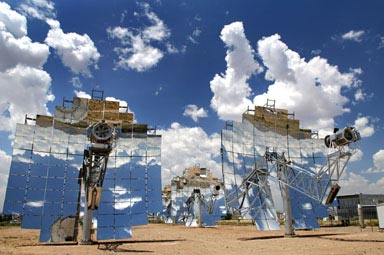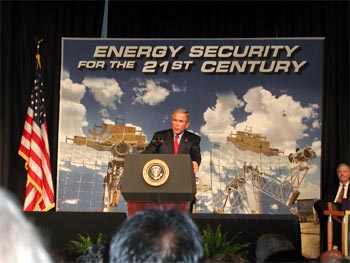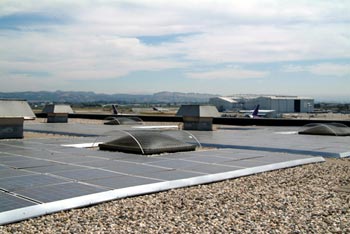California Solar Scene
Mojave Desert and Imperial Valley
 |
| For Stirling Energy Systems, the sky's the limit. |
by ADAM BRUNS,
Site Selection Managing Editor
The future of electric power in California is so bright, you've gotta wear shades.
Come again?
Yes, corporate interests are still wary about the state's overall power reliability, availability and affordability, but at least two new projects feeding into that grid hold great promise. One month apart this summer, Stirling Energy Systems and two major utilities have announced two solar energy collection projects in California that could generate as much as 1,750 megawatts — or the equivalent of a third of the energy produced by Calpine's current 41 generating plants in California.
Announced in August as the world's largest solar energy project, the project with Southern California Edison (SCE) will take place on a 4,500-acre (1,821-hectare) spread in the Mojave Desert 70 miles (113 km.) northeast of Los Angeles. The initial 500-megawatt project will begin with a 40-dish facility, then expand the sun splash to some 20,000 dishes. Then there's an option to add 34,000 more dishes after that. The second project, with San Diego Gas & Electric (SDG&E) will consist of a mere 12,000 dishes in its first phase, producing 300 megawatts, and located on three square miles (1,921 acres, or 777 hectares) in the Imperial Valley.
Robert Liden, executive vice president of SES, brings a deep background in investment banking and corporate finance to his role, so while some may still look askance at solar projects, he knows a good risk when he sees one. He tells Site Selection that the investment totals on these projects are confidential, in order to protect the pricing agreements with the utilities, but it's safe to say that a 500-megawatt dish farm spikes at well over half a billion dollars. As for site criteria, well, you can probably guess those.
"Our technology is such that it lends itself to hot arid areas, with lots and lots of sunshine," says Liden. While some NIMBY issues might have arisen, the fact is that Stirling's desired locations tend to be open contiguous space "out in the middle of nowhere, which is what we like to do," he says. Of course environmental permitting in California is another story entirely, case in point being the challenges faced by Hyundai's recent test track project, which had to first make way for an endangered turtle species. Liden says part of his company's due diligence was pinpointing sites where there weren't any obvious endangered wildlife situations. The sites also are far from community living spaces.
Helping the projects' viability is the Stirling engine technology behind the company's name. The engines' pistons are driven by heated hydrogen gas in tubes. "We don't require a lot of water," says Liden. "We have to wash the dust off the mirrors, but we're not using a steam generating process, so a small well is sufficient."
Last but not least, cost is an evident advantage, say the utilities.
"The contract requires no state subsidy and provides favorable pricing for ratepayers because tests have shown the SES dish technology can produce electricity at significantly lower costs than other solar technologies," said Alan Fohrer, SCE CEO, in August.
The Schwarzenegger plan's 3,000-megawatt goal was slated for a 10-year window, while the Stirling farms will meet their contractual obligations over a 20-year period. What's more, the Stirling projects fall under the 1,000 megawatts of concentrating solar power projects in the Southwest that the U.S. Dept. of Energy announced support for earlier in 2005.
Liden says the projects will benefit from the established federal investment tax credit equal to 10 percent of a project's total cost. The new federal energy bill adds some incentive,
 |
| President Bush addresses the captive audience at Sandia National Labs against a backdrop of SES's Solar Power Plant, prior to signing the Energy Policy Act of 2005. |
"With construction starting in 2008, we hope there will be an extension to that, extending several more years," says Liden. "The other main thing in the energy bill is a federal loan guarantee program, yet to be fleshed out, [whereby] the Dept. of Energy can offer loan guarantees for up to 80 percent of the capital costs of the project. That reduces the risk from a banker's standpoint."
Liden says the State of California offers some property tax abatements or reductions too. But the real attraction is the state's establishment of a renewable portfolio standard, requiring utilities to go out and get renewable, alternative sources of energy that fit in with their load profiles, says Liden. "You can't rely on wind to be the total answer," he says, because California winds tend to blow at night, whereas power demand comes in the middle of the day. SDG&E, for example, has pledged to provide 20 percent of that load from renewable resources, the state goal. Meanwhile, SCE, says spokesman Gil Alexander, has been in the renewables game longer than most, and already can lay claim to a 2004 renewables achievement of 18 percent. That's seven times the national average, he says.
"At a time of high natural gas prices, to advocate for renewables just makes sense," says Alexander.
Like the utilities, corporate solar projects are certainly not waiting for policy to catch up to practice. Two years ago, Toyota Motor Sales opened an $87-million sales office headquarters in Torrance, receiving Gold Level Certification from the U.S. Green Building Council's Leadership in Energy and Environmental Design (LEED) program for the 624,000-sq.-ft. (56,160-sq.-m.) project. And just this summer, Federal Express Corp. opened a
 |
 |
| LET THE SUN SHINE: "The solar-electric system at our Oakland hub powers one of our major FedEx Express hubs, which handles more than 260,000 packages daily and serves as a major gateway for shipments to and from Asia," said Mitch Jackson, managing director, corporate and international environmental programs, FedEx Express, in August. The solar-power installation at FedEx's new processing Oakland International Airport hub in will fuel 80 percent of the hub facility's energy needs. |
Assembly takes place not on a line, but at the sites themselves, one dish at a time.
"The process is straightforward," says Liden. "We lay out the dishes, auger holes in ground, and mount the pedestal. There is an 18-inch pipe that stands up about 16 to 17 feet above the ground, and the dish gets mounted on top of that on a rotary azimuth driver. The dish follows the sun."
While the installation will require hundreds of workers, operation of the facility will require 150 people. While solar facilities obviously don't operate 24/7, Liden plans to have people at the site round the clock.
One joint venture is under way in Johannesburg, South Africa. And another distinct possibility lurks on tribal lands right here in the U.S., which also carry some extra benefits spelled out in the new energy bill. Liden says SES has been working with a tribal energy resources council representing more than 80 different Native American tribes who have on their lands significant amounts of solar or wind resources, and SES is looking at where on such lands it might develop a solar project. However, as in California, political clouds can sometimes obscure the sun completely.
Liden says Arizona's Gov. Janet Napolitano would like to see a strong degree of solar energy development in the state, and he serves on her solar advisory council. But the Arizona Corporate Commission "has been extremely conservative with regard to establishing a renewable portfolio standard," says Liden, and so the battle is still uphill to develop solar in the state.
That said, tribal lands may offer an opportunity — possibly in the direct vicinity of certain non-renewable energy projects.
"Here in Arizona, the key areas are Hopi and Navajo tribal lands north of Flagstaff," Liden says. "Transmission is somewhat of an issue, as it is in almost any power plant these days." While tribal leaders with both the Navajo and Hopi have not been particularly aggressive in wanting to develop the process, he says, they are fully aware of the potential to develop large-scale solar on tribal lands. Today, however, both tribes are more occupied with the impending closing of the 1,580-megawatt Mohave Generating Station in Laughlin, Nev., which is powered by coal from Black Mesa mine on Hopi and Navajo property in Arizona, some 273 miles (439 km.) away. A slurry line carrying the coal uses substantial amounts of water, which many say is draining the Navajo aquifer.
Facing both a stressed aquifer and pressure from the U.S. EPA to clean up operations, the plant is being shut down at the end of this year by SCE pending resolution of the coal and water supply issues, and upon re-opening would be subject to an expensive upgrade process. SCE spokesperson Gloria Quinn says the Coconino aquifer, an alternative water supply about 100 miles (161 km.) from the mine, is being tested right now by the U.S. Dept. of the Interior to see if it could be used to support the mine and the coal slurry. Meanwhile, SES is proposing its own alternative.
"It's an economic trauma for the tribe, so we're proposing putting solar on their lands," says Liden, suggesting that leases and royalties might take up some of the economic slack. "It's being studied by Southern California Edison in conjunction with the tribes." Quinn confirms that a study of solar and other opportunities is being conducted right now, with a final report expected in October.
As it happens, Wayne Taylor, chairman of the Hopi Tribe, just last week received the Jay Silverheels Award, the highest honor granted by the National Center for American Indian Enterprise Development (NCAIED). Economic development has been central to his leadership, and there are indications that alternative energy could be too. In May of this year, Taylor, U.S. Dept. of Energy officials and executives from Headwaters Corp. met to discuss funding for a possible generating plant and coal liquefaction plant on Hopi lands, the latter to be used to make bio-diesel fuel.
In the meantime, also just last week, Southern California Edison terminated an interim plan that was trying to attract new power plants to Southern California.
Like a late-afternoon shadow's mirror image, all parties may be inclining gradually toward the desert sun.
©2005 Conway Data, Inc. All rights reserved. Data is from many sources and is not warranted to be accurate or current.